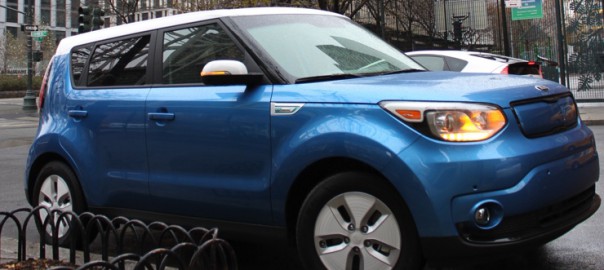It was a cold and rainy day in New York City, a thick fog ominously blanketing Manhattan in a muffling layer of grey. I had made my way into the city to spend an afternoon with the all-new 2015 Kia Soul EV, the company’s first all-electric, zero-emissions vehicle, and I was excited at the opportunity despite the Lovecraftian weather. How would the Soul, a car known as a fun, quirky, and uppity Urban Passenger Vehicle, handle the transition from piston power to electromagnetic locomotion? Would its range estimates hold true, or would anxiety creep in? How would the added battery weight affect its ability to handle Brooklyn’s dilapidated tarmac? I was about to find out.
Range
Let’s start with the #1 concern for electric vehicle buyers: range. Kia proudly proclaims an EPA estimated range rating of 93 miles with an MPGe of 92 miles highway and 120 miles city for a combined mileage of 105 miles. That pride is deserved, as it puts it second in the range department, behind only Tesla, but ahead of other competitors like the Ford Focus Electric or the Nissan Leaf. It’s a decent helping of miles, sure, but still not high enough for a prospective buyer to contemplate venturing very far outside city limits. This is not so much Kia’s fault as it is the reality of current EV technology.
Within the city however, I found that the car’s estimates were pretty much spot on. I drove from the Port Authority Bus Terminal in Manhattan to Sheepshead Bay in Brooklyn, and back to Carlstadt in New Jersey, for a roughly 45 mile trip. The car had been delivered to me with 89 miles of range, and I returned it with 43 miles left on the dial. This included two or three wide-open-throttle passes, and a fair amount of idling time, so I was impressed at the accuracy. Yes, while 93 miles isn’t as comforting as carrying around a 400 mile tankful of fossil juice, you should at least know that what you see on the dashboard really is what you get in real life.
Performance
The Soul EV carries a highly energy-dense battery that weighs 620 pounds, and is located in the floor, beneath the seats. This both lowers the center of gravity and stabilizes the cabin in potholes, contributing to a more comfortable, planted ride. The 60-volt, 192-cell, lithium-ion polymer, gel-electrolyte battery battery pack has a capacity of 27kWh, and an output of 81kW (109hp) and 210 lb.-ft. of instantaneous torque. And we need to emphasize that “instantaneous”, as this is the saving grace of otherwise seemingly underpowered electric motors. You get all your torque the second you step on the pedal, with no build-up like in a traditional combustion engine. This, coupled with the single-speed constant-ratio gear reduction unit, means you get pushed back into your seat and remain there with zero interruptions until you let off. Sure, the 0-60 times aren’t stellar, hovering around 11 seconds, but you don’t care as much because it feels fast. It’s a feeling that’s hard to describe to someone who’s spent their life driving vehicles that need to take tiny breaks between gears. But the point is that although the Soul EV is not a sports car, it definitely doesn’t feel sluggish.
Comfort and Silence
Additionally, the motor is almost completely silent. Kia explains this by saying that the “liquid-cooled AC synchronous permanent magnet motor uses multi-layer magnets to help improve efficiency and reduce the whine common to most electric vehicles.” This is important, because there’s nothing more annoying when you’re flooring it than to make a raucous; on a vehicle that outputs a little over 100hp, it’s great being able to squeeze every drop of power without alerting the entire neighbourhood that your ride is at its limits. Given the motor’s silence, all you’re left with is road noise and wind, which is kept at a minimum thanks to excellent sound-proofing.
Read more: Oh Gizmo
